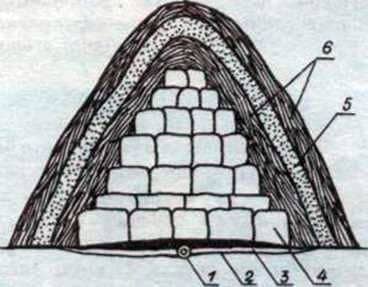Barn, cellar and glacier

1 – drainage pipe, 2 – slag, 3 – brushwood, 4 – ice, 5 – earth, 6 – straw
Procuring ice during the frost in any quantity is not particularly difficult.
Ice (river, etc.) must be prepared in a timely manner, when the thickness of the ice is the greatest, i. e. in January and February. For storage of ice choose a dry place, if possible on a hill and in the shade.
The cheapest and simplest method of storing ice is its folding (see the figure). The storage site must be pre-planned, make two slopes from the middle along the longitudinal axis of the rocket. On the slope axis, drains of 15 cm in diameter are laid. The whole surface is then covered with a layer of beaten slag, brick or gravel. On the prepared lining lay a layer of brushwood (branches), and on it exactly cut down blocks of ice.
The slots between them are filled with beaten ice (they are well permeated), and each layer is poured with water so that all the blocks are frozen into a monolith after freezing. After compiling the ice, the hagate is covered with straw, tiers, needles, hollows or dry foliage (about 60 cm thick), and then with a layer of earth (about 30 cm thick) and another layer of straw.
2.5 m3 of ice is laid on 1 m2 of the mantle. If a well-made glacier, the loss of ice over the entire season due to melting should not exceed 40%.
Meat and meat products can not be stored directly on ice, but only in dishes, on clean boards, etc.
Premises (if possible well-equipped), without which no household can do without, there is a barn and a cellar.
Barn is intended for short storage of small quantities of food products that do not quickly deteriorate and which the landlady uses several times during the day.
The cellar is designed for long-term storage of products that need a much lower temperature than in the barn.
The barn must be near the
The floor of the barn must be dense in order not to give access to rodents (forks, mice), and the walls are smoothly plastered and whitewashed with slaked lime. Only food products should be stored in the barn. You can not put kerosene, gasoline, various lubricants, mineral fertilizers, etc.
The barn equipment consists of shelves on the walls, various poles for hanging onions of onions, garlic, and also a tavern, a variety of potions, mushrooms, etc., a table with boxes, weight, household measurements, a chest for flour, cereals and t. p., board for cutting meat, lard, wild boar and other meat products, jugs, wooden bars-bags.
The barn must be dry, with good ventilation and cold – in winter the temperature in it should not fall below 0 њ C, and in summer it should rise above 12 њ C. It is very important to frequently check the quality of products that are stored.
The cellar is made separately or under a house that is much more practical. Its characteristic feature is the deepening at 2-2.5 g. The entrance to the cellar can be stairs from the kitchen, the porch or from the barn. The walls are wooden or under construction (concrete) and whitewashed with lime, the floor is concrete or clay.
To maintain a low temperature in the cellar, you can put ice. A well-equipped cellar should be divided by partitions or walls into a compartment for potatoes, vegetables, pickles, etc. On the walls you need to make shelves, fix the poles, hooks and other devices, and on the floor make pads under the barrels.
The cellar equipment (partitions, shelves, barrel linings, etc.) must be dismounted so that it can be dismantled, removed, washed, dried and put back in place. The cellar should be dry, and the temperature in it without large fluctuations and keep within 0-8 њ C, have good ventilation and be ventilated on fine days (even in winter). The best temperature for storing meat and fats (in barrels or jugs) is 0-2 њ C. In such conditions, meat can be kept for several weeks, and salted for several months. Parts of the chopped carcass, suspended so as not to affect each other, at a temperature of 5-7 њ C, 2 days remain.
Barn, cellar and glacier
